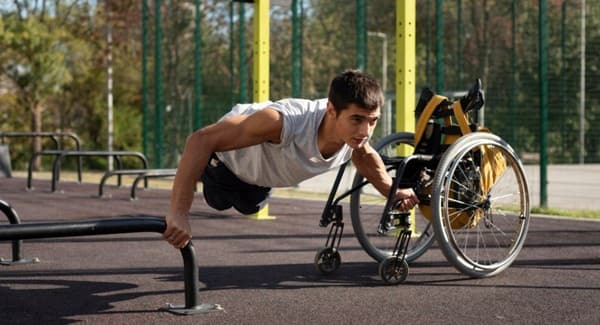Previously, the sports equipment intended for disabled individuals was either semi-functional, costly, or out of reach. Fortunately, there have been improvements in these fields: advances in material science, biomechanics, and AI technology have remodeled adaptive sports gear, making it more accessible, competitive, and individualized than ever before.
Modern adaptive racing wheelchairs and sprinting smart prosthetic legs are not just functional, but elite. This sophisticated adaptive sports equipment enables athletes of all abilities to strive for greatness.
More Innovative Gear, Smarter Athletes

Frequently, the most significant changes in adaptive equipment come from a shift towards smart technology. Modern equipment comes with sensors and AI technology, making it no longer static but active machinery that improves the athlete’s movements.
For athletes using a wheelchair, high-performance wheelchairs are created with 3D modeling and motion capture integrated alongside biomechanical analysis in real time for better speed, control, and maneuverability. As interest grows, fans tracking performance innovation through platforms for online betting can now find more data and context around adaptive events, especially as competitive parity rises and new formats emerge.
Or, for example, you can consider prosthetics. Today’s AI-assisted prosthetic limbs can dynamically change grip strength, tension, and stride length with respect to the users’ movements, along with the surrounding surface conditions. These tools are not designed for all people, which means they are not off-the-shelf devices but rather systems customized to every athlete’s anatomy and physical characteristics in addition to the particular sport.
Innovation from the Lab to the Field
The combination of engineers, athletes, and medical personnel makes today’s adaptive equipment so groundbreaking. Systems are being designed hand-in-hand with the users, right down to the grips and ratios.
AI has its place in prototyping as well. Engineers can run thousands of iterations in virtual reality before having physical models by pretending that stress, movement, and force application occur. This lowers the cost, improves the systems, and speeds up the innovation cycle. In team sports, such as wheelchair rugby or adaptive soccer, the equipment is now customized down to the finest detail—because precision is the difference between gold and silver.
Social Visibility Drives Innovation
Adaptive sports have finally started getting the attention they deserve due to social media and streaming platforms, leading to more investment in tech performance. With more eyeballs comes more investment, especially in performance tech.
As athletes share their training routines, competition moments, and gear, younger athletes get motivated, giving brands more reason to invest in adaptive sports. Want to follow along with this momentum? MelBet Instagram often shares inspiring moments from athletes and tech innovations redefining competitive edges in adaptive sports.
Where AI and Wearables Fit In
Wearable gadgets have transformed how people monitor and improve their performance. For adaptive athletes, these devices provide additional benefits such as detailed analysis considering personal movement patterns, overall stress, and balance. Such individuals now finally have all the personal benefits they require.
AI also gives the athlete additional capabilities by processing information in real time and giving strategy updates instantaneously, such as providing coaching advice, alerts to prevent injuries, and recommendations for equipment changes. With time, technology improves, noticing significant changes over time and aiding in improving strategies for the athletes and their trainers.
From athletes who trained on only a sensation and rote learning basis, they can now analyze their performance with advanced analytics, accessible from mobile phones and smart watches.
What’s New and Next in Adaptive Sports Tech
Here is the list of innovations that are revolutionizing the industry’s use of technology as mentioned above:
- Prosthetic limbs powered by AI that adapt to the user’s movement and surroundings.
- Exoskeletal devices for balance sports and track and field events are produced using 3D printers.
- Smartwheel racing chairs and court chairs.
- Specially fitted grips based on statistical data of certain athletes.
- Simulations for training using VR technology that replicate actual game situations.
These technologies are in use now and are not proposed for the future.
Bringing the Benefits to More Athletes
One of the most significant goals in advancing adaptive tools is widening the scope of access. Many regular, would-be athletes don’t have the sponsorships and funding that elite athletes do. This is why researchers are paying attention to economically viable raw materials, modular apparatus designs, and open-source hardware designs.
This gap is also being reduced with the help of AI. Artificial Intelligence brings smart training recommendations that use simple and inexpensive equipment, alongside offering staff who don’t rely on lab tools, and therefore, enables most users to receive elite coaching. These tools permeate schools, rehab centers, and youth sports programs. Because of them, the new wave of disabled athletes is guaranteed more significant advantages than their predecessors.
Final Thoughts
No longer an opulent privilege, sports technology has become a prerequisite. State-of-the-art equipment, such as customized apparel and integrated coaching, aids athletes in achieving peak performance while broadening the range for new participants to join.
As time progresses, the implementation of AI and innovative technology will continue revolutionizing adaptive sports. This process emphasizes that appropriate equipment levels the playing field, thus anybody can achieve exceptional success.

